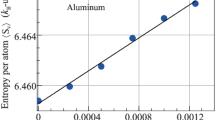Abstract
A phenomenological model has been proposed that allows the volume change on melting of metals to be related to the valence, thermodynamic properties, and crystallographic parameters of the solid phase. Basic to the model are ideas that a phonon “analog of the Casimir force” plays a key role in determining the metal melting process.
Similar content being viewed by others
References
Fortov, V.E., Uravneniya sostoyaniya veshchestva: ot ideal’nogo gaza do kvark-glyuonnoi plazmy (Equations of State for Matter: From Ideal Gas to Quark–Gluon Plasma), Moscow: Fizmatlit, 2013.
Zinov’ev, V.E., Teplofizicheskie svoistva metallov pri vysokikh temperaturakh (High-Temperature Thermophysical Properties of Metals), Moscow: Metallurgiya, 1989.
Struktura i svoistva metallov i splavov. Teplovye svoistva metallov i splavov (Structure and Properties of Metals and Alloys. Thermal Properties of Metals and Alloys), Larikov, L.N. and Yurchenko, Yu.F., Eds., Kiev: Naukova Dumka, 1985.
Martynov, G.A., Klassicheskaya statisticheskaya mekhanika. Teoriya zhidkostei (Classic Statistical Mechanics. Theory of Liquids), Dolgoprudnyi: Intellekt, 2011.
Ryabov, V.A., Printsipy statisticheskoi fiziki i chislennoe modelirovanie (Principles of Statistical Physics and Numerical Simulation), Dolgoprudnyi: Intellekt, 2014.
Chuvildeev, V.N. and Semenycheva, A.V., The role of the “Casimir force analogue” at the microscopic processes of crystallization and melting, Ann. Phys., 2016, vol. 373, pp. 390–398. doi 10.1016/j.aop.2016.07.010
Sanditov, D.S. and Bartenev, G.M., Fizicheskie svoistva neuporyadochennykh struktur (Physical Properties of Disordered Structures), Novosibirsk: Nauka, 1982.
Fizicheskie velichiny (Physical Quantities), Grigor’ev, I.S. and Meilikhov, E.Z., Eds., Moscow: Energoatomizdat, 1991.
Touloukian, Y.S., Kirby, R.T., Taylor, R.E., and Desai, P.D., Thermophysical Properties of Matter. The TPRC Data Series. Thermal Expansion Metallic Elements and Alloys, New York: Plenum, 1975, vol. 12.
Casimir, H.B.G., On the attraction between two perfectly conducting plates, Indagationes Math., 1948, vol. 10, pp. 261–263.
Genet, C., Lambrecht, A., and Reynaud, S., Temperature dependence of the Casimir effect between metallic mirrors, Phys. Rev. A, 2000, vol. 62, paper 012 110. doi 10.1103/PhysRevA.62.012110
Harrison, W., Electronic Structure and Properties of Solids. The Physics of the Chemical Bond, San Francisco: Freeman, 1980.
Kittel, Ch., Introduction to Solid State Physics, New York: Wiley, 1953.
Frost, H.J. and Ashby, M.F., Deformation-Mechanism Maps: the Plasticity and Creep of Metals and Ceramics, New York: Pergamon, 1983.
Svoistva elementov (Properties of Elements), Drits, M.E., Ed., Moscow: Metallurgiya, 1985.
Regel’, A.R. and Glazov, V.M., Periodicheskii zakon i fizicheskie svoistva elektronnykh rasplavov (Periodic Law and Physical Properties of Electronic Melts), Moscow: Nauka, 1978.
Sokolovskaya, E.M. and Guzei, L.S., Metallokhimiya (Metal Chemistry), Moscow: Mosk. Gos. Univ., 1986.
Tablitsy fizicheskikh velichin (Tables of Physical Quantities), Kikoin, I.K., Ed., Moscow: Atomizdat, 1976.
Frantsevich, I.N., Voronov, F.F., and Bakuta, S.A., Uprugie postoyannye i moduli uprugosti metallov i nemetallov (Elastic Constants and Elastic Moduli of Metals and Nonmetals), Kiev: Naukova Dumka, 1982.
Wray, P.J., Volume change accompanying solidification, Metall. Trans., 1974, vol. 5, no. 12, pp. 2602–2603. doi 10.1007/BF02643883
Arsent’ev, P.P. and Koledov, L.A., Metallicheskie rasplavy i ikh svoistva (Metallic Melts and Their Properties), Moscow: Metallurgiya, 1976.
Metal Reference Book, Smithells, C.J., Ed., London: Butterworths, 1976.
Ubbelohde, A.R., The Molten State of Matter, New York: Wiley, 1978.
Chuvil’deev, V.N., Micromechanism of self-diffusion in molten metals: part 1, Rasplavy, 1996, no. 2, pp. 9–19.
Author information
Authors and Affiliations
Corresponding author
Additional information
Original Russian Text © V.N. Chuvil’deev, A.V. Semenycheva, 2017, published in Neorganicheskie Materialy, 2017, Vol. 53, No. 7, pp. 781–785.
Rights and permissions
About this article
Cite this article
Chuvil’deev, V.N., Semenycheva, A.V. Model for the calculation of the volume change on melting of metals. Inorg Mater 53, 770–773 (2017). https://doi.org/10.1134/S0020168517070020
Received:
Published:
Issue Date:
DOI: https://doi.org/10.1134/S0020168517070020




